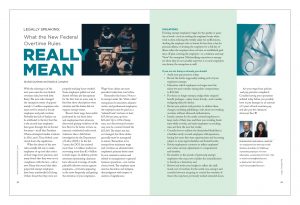Legally Speaking: What the New Federal Overtime Rules Really Mean
With the ushering in of the new year came the new federal overtime rules, but with little flurry. The new rules changed the exemption status of approximately 1.3 million employees who must now be treated as hourly employees and paid overtime. Probably the lack of fanfare can be attributed to the fact that this is the second time employers have gone through this in the last few years—recall that President Obama attempted similar revisions in 2016, and a Texas federal court struck down the regulations.
What the advent of the new rules actually did was to make employers sit up and take notice of their wage-hour practices, and many found that they were not in compliance with the law—old or new. Many discovered that their purported exempt employees have been misclassified all along. Others found that they were not properly tracking hours worked. Some employers pulled out and dusted off their job descriptions for the first time in years, only to find that those descriptions were obsolete and the duties did not support exempt status.
Recent client wage-hour audits performed by our firm’s labor
and employment law attorneys discovered glaring violations of the law. But it is far better to have an internal, confidential audit reveal violations than a full-blown investigation by the Departmentof Labor (DOL). In the last 5 years, the DOL has assisted more than 1.3 million workers in recovering more than $1.4 billion in back wages. In addition, private attorneys representing claimants have advanced a barrage of multi-plaintiff collective actions against employers—civil suits appearing in the news frequently and getting the attention of your employees. Wage-hour claims are more prevalent today than ever before.
Remember the basics: Now, to be exempt under the “white collar” exemptions for executive, administrative, and professional employees, the employee must be paid on a “salaried basis” and earn at least $35,568 per year, up from $23,660. Up to 10% of lump sum, non-discretionary bonuses may now be counted toward the $35,568. The duties test has not changed, but those duties generally must be managerial in nature. Remember, to be exempt from minimum wage and overtime, an administrative employee’s primary duties must be non-manual in nature and related to management or general business operations—not routine clerical work. The employee must exercise discretion and independent judgment with respect to matters of significance.
Violations
Docking exempt employees’ wages for the quality or quantity of work—such as sending the employee home when work is slow, reducing the weekly salary for inefficiencies, docking the employee who is absent for less than a day for personal affairs, or docking the employee for a full day of illness when the employer does not have an established paid time off plan covering the employee—is a violation and may “blow” the exemption. Misclassifying executives as managers when they do not actually supervise 2 or more employees can destroy the exemption as well.
If you are not doing so already, you should:
- Audit your pay practices today;
- Revisit the duties supposedly making each of your employees exempt;
- Determine which employees no longer meet the salary test and consider raising their compensation to $35,568;
- For those no longer exempt, realign their assigned benefit packages—salary versus hourly —and consider realigning their job duties;
- Revise your policies and practices to address these changes, including publishing a rule about not working overtime without advanced authorization;
- Install a system for the newly covered employees to keep track of their time and their non-working break time while at work, and train employees on tracking time and how the new law works;
- Consider how to address the diminished flexibility in schedules newly covered employees will experience, having lost some flex-time opportunities and becoming subject to more rigid schedules and formal breaks;
- Revise employment contracts to reflect employees’ new status and any adjustments to compensation and benefits;
- Be sensitive to the morale of previously exempt employees who may now consider the reclassification to hourly as a demotion; and
- Review and revise your budget to reflect the additional cost of overtime for the newly non-exempt, and consider how you are going to control the overtime of those who may have previously worked extended hours.
Are your wage-hour policies and pay practices compliant? Consider having your operations audited today before you possibly have to pay damages in an amount of 3 years of back overtime pay, and also pay the claimants’ attorneys’ fees.

